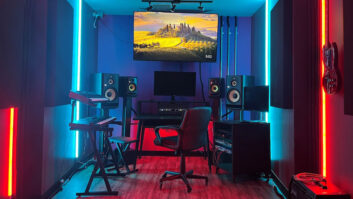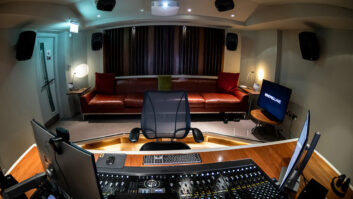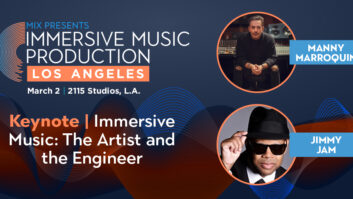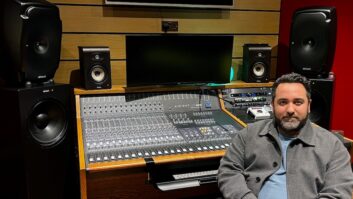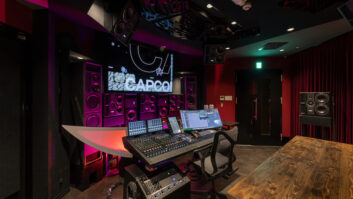
Last month in this column I started yet another discussion on themyriad dangers facing studio owners from the constant pressure toupgrade gear, both hardware and software. This problem has been gettinga lot of attention lately, and it was the topic of an entertaining andenlightening panel (which I had the pleasure of moderating) at Mix’sStudioPro98 conference in New York City, held last June. This month I’mgoing to focus on what the folks on the panel had to say.
The session could easily have been a gripe-fest for studio ownersand engineers, but I wanted other sides to get their licks in as well.Manufacturers, if they want to stay in business, are taking this issuepretty seriously. They’re caught in a similar sort of bind as studioowners: On the one hand, if their products have a reputation forbecoming obsolete in short order, they will lose sales; but on theother hand, it’s impossible, no matter how much upgradeability they tryto build into a product, to keep it on the leading edge forever. On yetanother hand (hey, I’m a writer-I can do things like create people withthree hands!), if they make their products too upgradeable, they’llsaturate their markets, and sales of new products will fall off.
Like computer software manufacturers, a lot of audio companies arefinding themselves in the “subscription” business as well as (or eveninstead of) the “black box” business. The ratio between the amount ofsupport that sort of enterprise demands and its revenues can be quite ashock to a company that previously only had to worry about how manyhardware units got out the door each month. So I invited severalmanufacturers to sit on the panel and present their cases.
Retailers, too, are part of the upgrade equation and can helpcustomers with loan, rental, leasing or trade-in programs that cansoften the blow should an expensive piece of gear prove obsolete,inappropriate or simply unfashionable. Dealers can also, if they aretaking their job seriously, do a lot to facilitate communicationbetween manufacturers and end-users.
The panelists from the manufacturing side were Bob Reardon, directorof product development for desktop products at Lexicon, a longtimestudio owner himself, as well as an experienced post-productionengineer and friend over the years; Laura Tyson, regional sales managerfor Roland; and Robert Miller, Northeast regional post-productionspecialist for Digidesign. The retail segment was represented by BlueWilding from Dale Pro Audio in New York. To represent working studios,I was pleased to get Zoe Thrall, president of Avatar (formerly PowerStation), from the record side; Tim Leitner, chief engineer at a NewYork boutique house McHale Barone, from the advertising side; and DannyCaccavo, staff engineer at Sync Sound, who also owned his own shop fora long time and is an old friend, from the high-end post side.
Leitner, like most of us who pay the bills, sees the major problemas being able to strike a balance between being current and stayingsolvent. “We are dedicated to keeping our three main studios on thecutting edge,” he said, “from 24-bit digital recording to using LCDscreens rather than CRTs, and even 5.1 mixing in one room. Fortunately,even though these advancements come at a cost, what we are capable ofaccomplishing today greatly exceeds what we could do just a few yearsago, and at a much lower cost. But since we have such a largeinvestment in hardware, and because our business has been growing soquickly, we have chosen to keep our older systems in use and relegatethem to less important rooms, where they are still functioning, if alittle less efficiently than the newer systems.”
Caccavo spoke about the pressures on a facility to upgrade: “I havefound that, especially in the DAW community, many users are driven toupgrade merely because of ‘fast and cool’ factors. When presented withthe ‘latest and greatest,’ many of us fall prey to our own gear-lustrather than using more appropriate factors to make a decision.
“The first thing you need to ask yourself when presented with anupgrade decision is: Will this upgrade ultimately make me more money?”he continued. “If I buy this upgrade, which will allow me to finish thejob faster, can I raise my studio rates? Because if I can’t, then Icould end up making less revenue on each job. You really have to walkthe line on this one. You don’t want to be perceived as a taxi driverwho overcharges by taking someone to LaGuardia by way of Kennedy, butyou also don’t want to work so quickly that you cut down too much onyour billable hours-unless you increase your rates. And in the currentcut-rate climate, this may not be easy.”
Thrall talked about her struggles with adopting new formats: “AtAvatar, I was dragged kicking and screaming into adding ADATs andDA-88s. I used to argue that these were not professional products, andthey have no place in a state-of-the-art facility, but almost every dayI have a client who is using one of those formats, and almost everymajor engineer and producer who’s worked at Avatar has at some pointhad to rent one of them. I can’t ignore numbers like that.
“The most important thing in making these purchasing decisions is toknow who your clients are and to be aware of how your facility fitsinto the audio industry within your city,” she continued. “A studio’sbusiness is driven by its clientele. Listen to them. Ask them questionsabout their needs, and evaluate them. If you find yourself continuallyrenting a piece of equipment, it may be time to purchase it. On theother hand, renting new technology lets you see if radical changes aregoing to take place that will render it obsolete, and if that happens,you don’t lose a large investment. Also, if you can establish arelationship with one or two local retailers, sometimes they will letyou try something out for a week to see if your staff and the clientslike it.
Caccavo formulated a few useful questions that studios can askthemselves before committing to an upgrade: “Will it attract newclientele?” he asked. “Will your current clients even notice it if youdon’t tell them about it? Will they just think I’m showing off if Idotell them about it? Most of my clients are lukewarm on the idea of newstuff in the room. Their first reaction is usually, ‘Does it crash alot?’ So I stopped telling them about it. When I went to a DAW-basedsystem, for me it was really cool to eliminate the console, but mostclients actually felt more nervous about the lack of tactilecontrols.
“Are you upgrading because of real competition,” he asked, “or justbecause you want yours to be bigger than theirs? It is easy to beseduced by the latest MacWarehouse catalog or the latest postcardupgrade offer. After all, companies offer you upgrades because theywant you to upgrade, not out of the kindness of their hearts.
“Whom are you really trying to please with this upgrade? The client,or yourself? If it’s you, it doesn’t necessarily mean you shouldn’t doit. You might draw a parallel between your getting an upgrade and aguitar player getting a new amplifier that produces a tone that’s morepleasing to him. Just as a better sound may inspire a betterperformance from that guitar player, a faster and cooler DAW mayinspire a better ‘performance’ from you, the engineer.
“Of course,” he added, “this may be complete bullshit, but hey, it’sa great rationalization, isn’t it?”
Thrall had some further words for manufacturers: “One thing they alltell us is that, ‘If you purchase my product, your rate can increase byx.’ That’s usually a bunch of nonsense. When a manufacturer is talkingto a studio, they should ask us about the sessions that take placethere. If they know more about our business, it will be easier to sellus something-even to sell us something we hadn’t considered. Doing yourhomework can pay off.”
Leitner also spoke to the manufacturers: “From my experience, thecompanies that I have been dealing with have done a fairly good job ofproviding reasonable upgrade paths. My biggest complaint withmanufacturers is really a matter of timing. Sometimes the desire toannounce a new product with the latest and greatest features precedesactual shipping product by several months, if not longer. I don’t wantto buy and install buggy hardware or software, but neither do I want tomake purchasing plans based on vaporware. I think that manufacturersneed to act a bit more responsibly in this area.”
From the hardware-makers’ point of view, Lexicon’s Reardon had thisto say about his company’s philosophy on making its productsupgradeable: “Longevity and upgradeability are of concern during thedesign phase of all our products, and they’re part of our ‘valueequation.’ But that typically makes the products cost more initially.Achieving the correct balance between user expectations andtechnological and financial realities is a challenge. Our industry hasplenty of examples of artistic and technological successes that werebusiness failures-anyone remember ARP?”
Reardon thinks that issues of upgradeability are largely determinedby forces outside of individual companies: “What is increasinglyimportant is the adoption of standards,” he said. “This will help morethan anything to keep equipment from becoming obsolete. However,standards are increasingly driven from outside our industry. This makesthe collaboration between users, professional organizations andmanufacturers-to propose and develop achievable standards in a timelyfashion-very important.”
Roland’s Laura Tyson talked about the difference between “hardware”upgrades and “software” upgrades. “If you buy a hardware-based digitalworkstation, are you stuck with the product exactly as it is the firstday you take it out of the box?” she asked. “No. Many people perceivehardware-based recording systems to be closed-ended, and this is simplynot true anymore. And thanks to the Internet, manufacturers now have afast and easy method to distribute software upgrades to customers.Internet-based user groups help spread the word, so now it’s impossiblefor a manufacturer to keep information about upgrades a secret, even ifthey wanted to.”
Switching gears, she offered a blunt word of warning to her fellowmanufacturers: “There used to be something called ‘Customer Loyalty,’but now that’s an oxymoron. Manufacturers cannot assume a customer willbe loyal to a specific brand name. Each and every product amanufacturer builds must be well-designed, and desirable on its own,without relying on customer loyalty to boost sales. Sure, brand-namerecognition will get you a long way, but if the product is poorlydesigned, it won’t be successful.”
Since the panel went on for an hour-and-a-half, obviously much morewas said, but this will give you a taste of how these people see theissues. I’ll give Danny Caccavo the last word: “Sometimes I’ll listento something I did ten years ago and be surprised at the quality andcreativity I achieved without any DAWs at all. It’s a soberingthought.” Indeed it is.
Next month, a personal account of a trip to Upgrade Hell…

